

Broadview Freedom School Provides Lesson On Education’s Importance
Participants in the Lindop summer program stressed public education’s continued relevance
By MICHAEL ROMAIN Editor
Alanna Moore, a rising third-grader at Lindop Elementary School, 2400 S. 18th Ave. in Broadview, shared her thoughts on the importance by filming a short YouTube video that visitors could view by pointing their phones at a QR code near a poster in the hallway.
“Public education is good because it’s free, and everyone can go to school and learn,” Moore said. “Even if your family doesn’t have a lot of money, you can still get a great education and learning important things like reading and writing. We can make it even better by helping teachers learn more ways to teach.”
Moore’s appeal was part of the broader message shared during the National Day of Social Action on July 17, one of the culminating events hosted by Lindop’s Broadview Freedom School program.
Now in its third year, Broadview Freedom School is a six-week summer program for Lindop Elementary students modeled on the famous 1960s-era Freedom Schools hosted by civil rights activists in Mississippi. The schools rigorously taught civic literacy and other subjects in a safe, welcoming environment for Black students.
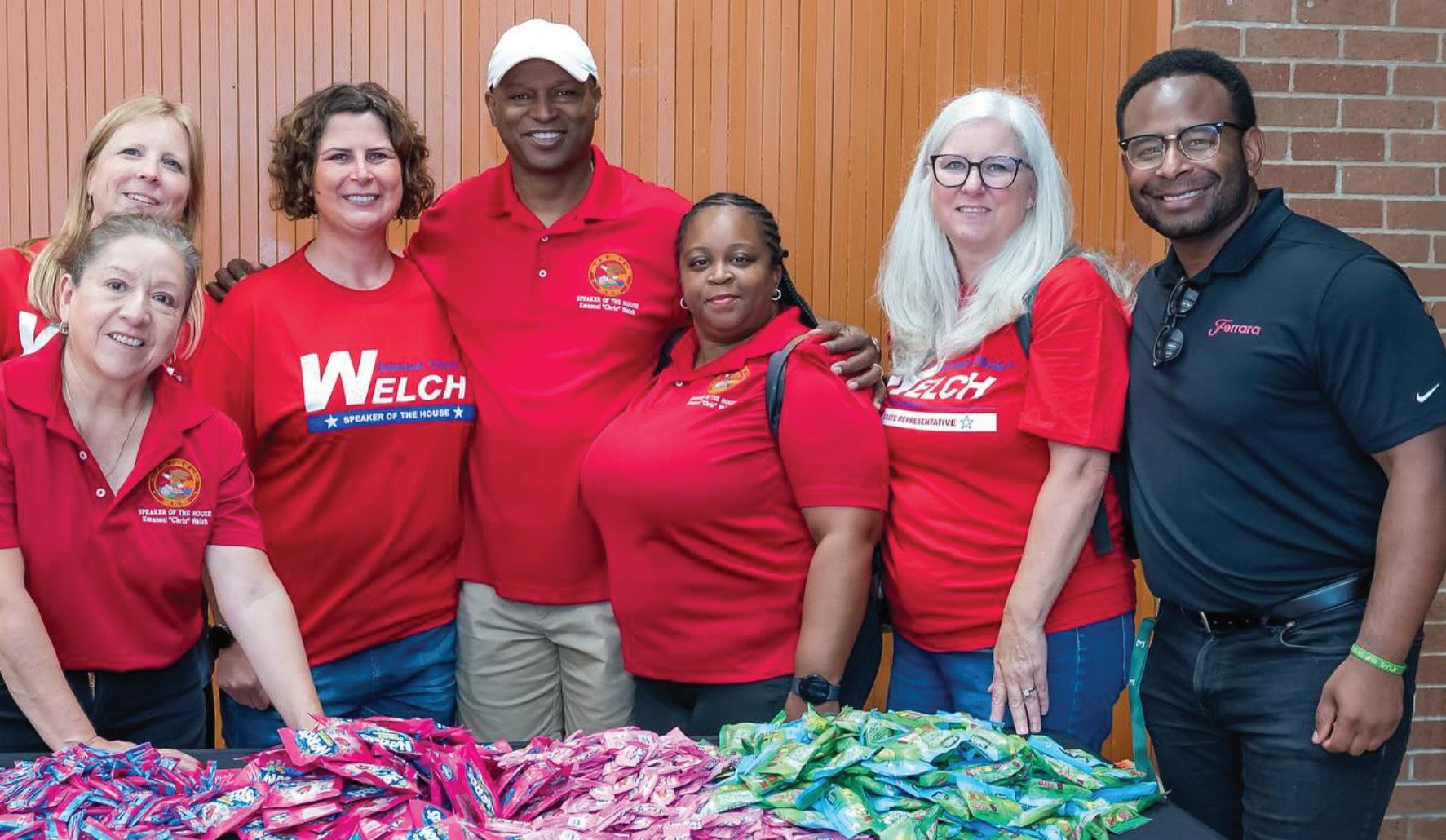
Illinois House Speaker Emanuel “Chris” Welch and his staffers give out free items at the Speaker’s
School Health Fair at Proviso West High School in Hillside on July 26. See more photos on page 3.
Media Literacy Education Lacks Consistency Across Illinois
State law requiring instruction was passed three years ago
By JASON PISCIA AND DR. ANN STRAHLE Capitol News Illinois
SPRINGFIELD — A survey of Illinois educators reveals a significant disparity in how they interpret a three-year-old state
law’s requirement to teach high school students a “unit of instruction” on media literacy.
About one-third of respondents to a survey conducted by the University of Illinois Springfield indicated they spend more
than one class period but no more than one week covering the topic, while about 29 percent spend more than three weeks’ worth of class periods. Sixteen percent of
COURTESY SPEAKER EMANUEL “CHRIS” WELCH
Back to

Publisher/CEO Michael Romain
Chief Operations Officer Kamil Brady
Creative Designer Shanel Romain
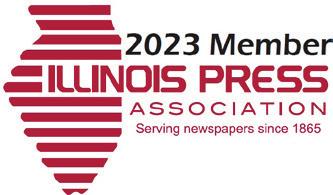
HOW TO REACH US
John Wilk Communications, LLC
3013 S. Wolf Rd. #278
Westchester, IL 60154
PHONE: (708) 359-9148
VFPress.news
TWITTER: @VILLAGE_FREE
FACEBOOK: @MAYWOODNEWS

How My Office Handles Billions — And Protects Every Penny
Two times a year, my office mails nearly 1.8 million property tax bills and collects over $18 billion. That’s not a typo — $18 billion. As Cook County Treasurer, I oversee the second-largest property tax collection and distribution system in the United States. Only Los Angeles County is bigger.
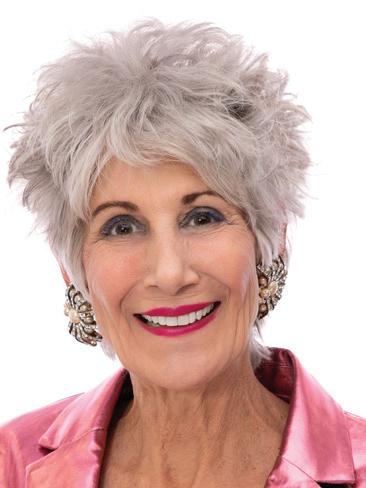
MARIA PAPPAS
The Village Free Press is published digitally and in print by John Wilk Communications LLC. The print edition is distributed across Proviso Township at no charge each week. © 2025 John Wilk Communication LLC

But I do far more than send out bills. My office is the financial heartbeat of Cook County. We collect tax payments and distribute those funds to nearly 2,200 local government agencies — from school districts and libraries to police departments, parks and public health systems. They in turn put that money to work so it’s ultimately returned to you in the form of vital government services.
These institutions depend on our accuracy and timeliness to keep your neighborhoods safe, your streets lit and your children educated.
Every dollar that comes in must be safeguarded, tracked and reported. I’ve built an investment policy that complies with all federal and state laws, prioritizes the safety of your money, and ensures we always have enough cash on hand to meet the County’s obligations. Risk is minimized through diversification. While investment returns matter, protecting your tax dollars comes first — always.
Cook County Treasurer
Government should not be a mystery. My job is to make sure your money is handled with precision, integrity and absolute transparency.
When taxes go unpaid I must prepare delinquency lists, notify taxpayers, obtain court orders and conduct the annual tax sale, a legal process to recover unpaid taxes. This system isn’t designed to punish — it’s built to enforce fairness. Everyone must pay his or her fair share. My office also handles refunds when you overpay. Whether because of a duplicate payment, a reduction in your property’s assessed value, or a court-ordered change in tax rates, we ensure that overpayments are returned. Currently my office has $122 million in available refunds from overpayments going back to 2005. And we have an additional $33 million in missed exemption payments going back to 2021. Those years are firm legal deadlines. By law, you can only get back overpayments going back 20 years and exemptions going back four. So, if you don’t apply in time, you could lose the refund you’re owed. And we don’t want that to happen. That’s why we’ve made it easier to check your property’s refund status on our website, cookcountytreasurer.com, for free — no lawyer or middleman required.
By law, I’m also responsible for submitting financial reports to the Cook County Board of Commissioners, managing trust funds and other special accounts and investing and safekeeping the money that funds county services.
Government should not be a mystery. My job is to make sure your money is handled with precision, integrity and absolute transparency. When the tax system works fairly, it builds trust. When it builds trust, it strengthens communities. That’s the work we do every day — managing billions so that democracy works.
WELCH’S BACK-TO-SCHOOL HEALTH FAIR


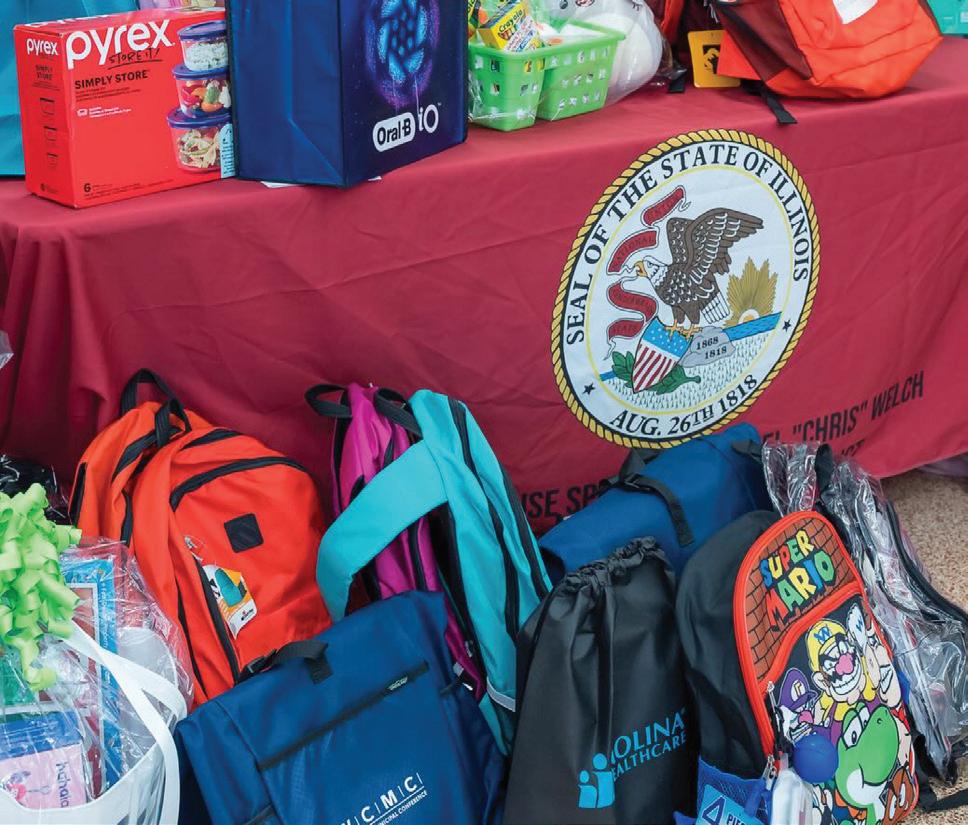
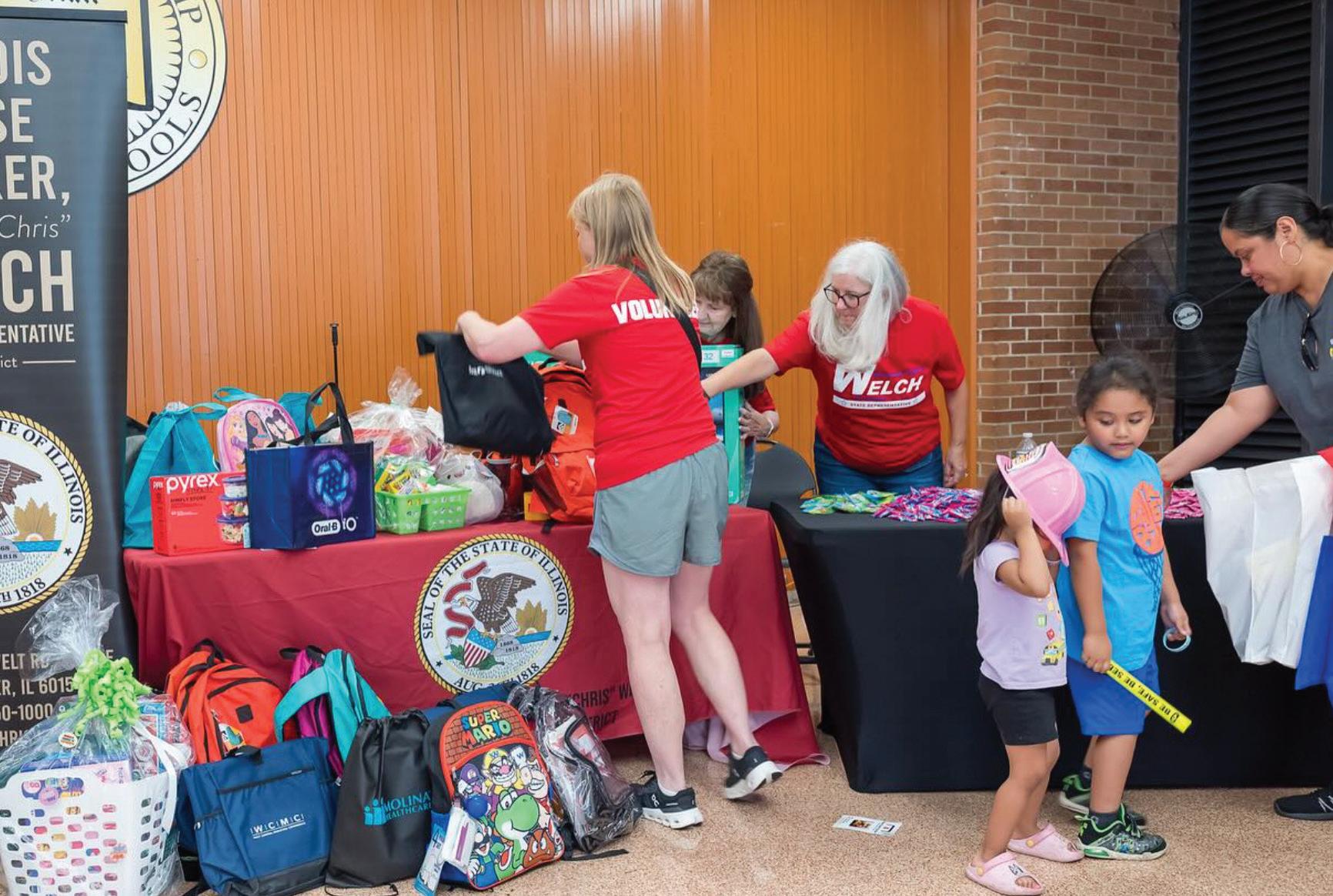
Hundreds converged on Proviso West High School in Hillside on July 26 to get free back-to-school supplies, health services, and other resources during Speaker Emanuel “Chris” Welch’s Back to School Health Fair.
PHOTOS COURTESY SPEAKER EMANUEL “CHRIS” WELCH
FREEDOM SCHOOL
Growth lauded
from page 1
That welcoming environment lingers in the Freedom Schools’ modern iteration in Broadview, home to the only certified Children’s Defense Fund Freedom Schools Site in Proviso Township and among just a handful in the state.
During Broadview Freedom School’s finale on July 24, Sharee Younger, a parent with children in the program, praised the school’s welcoming environment.
“That growth and pride they have in themselves is not accidental,” Younger said, referencing the young people who participate in the Broadview program. “It’s nurtured by the teachers who show up every day with so much heart. You can see it in their presence and care, and how they make every child feel supported. … This isn’t just academics. This is about building identity, strengthening confidence, and creating safe and empowering spaces for our kids.”
Freedom School teachers Cameron Coppage and Tom Mousheh attributed the students’ growth, in part, to the bonds they shared.
“It’s really cool getting to bond with every kid individually,” Coppage said. “Our group sis awesome, they’re really mature for their age.”
“We can relate more to them than they expected, which is nice,” Mousheh said. “The topics they bring up, we understand them, and so it’s so much easier to have conversations with them.”
Broadview Mayor Katrina Thompson, whose office was instrumental in securing the $350,000 state grant that launched the program, said she wants to see Freedom Schools established in other Proviso Township suburbs.
“If we say we want every kid to go to college and give them opportunities, we have to plant the seed,” Thompson said on July 17. “Freedom School plants that seed. When you do the QR codes and hear these young people speaking, they’re not shy. There’s growth since the beginning of the program to now, six weeks later.”
You can view Broadview Freedom School’s 2025 finale on YouTube at youtube.com/watch?v=2XuMUwzoQRU.
Full Disclosure: Village Free Press helped launch Broadview Freedom School in 2023.
More pics on page 6
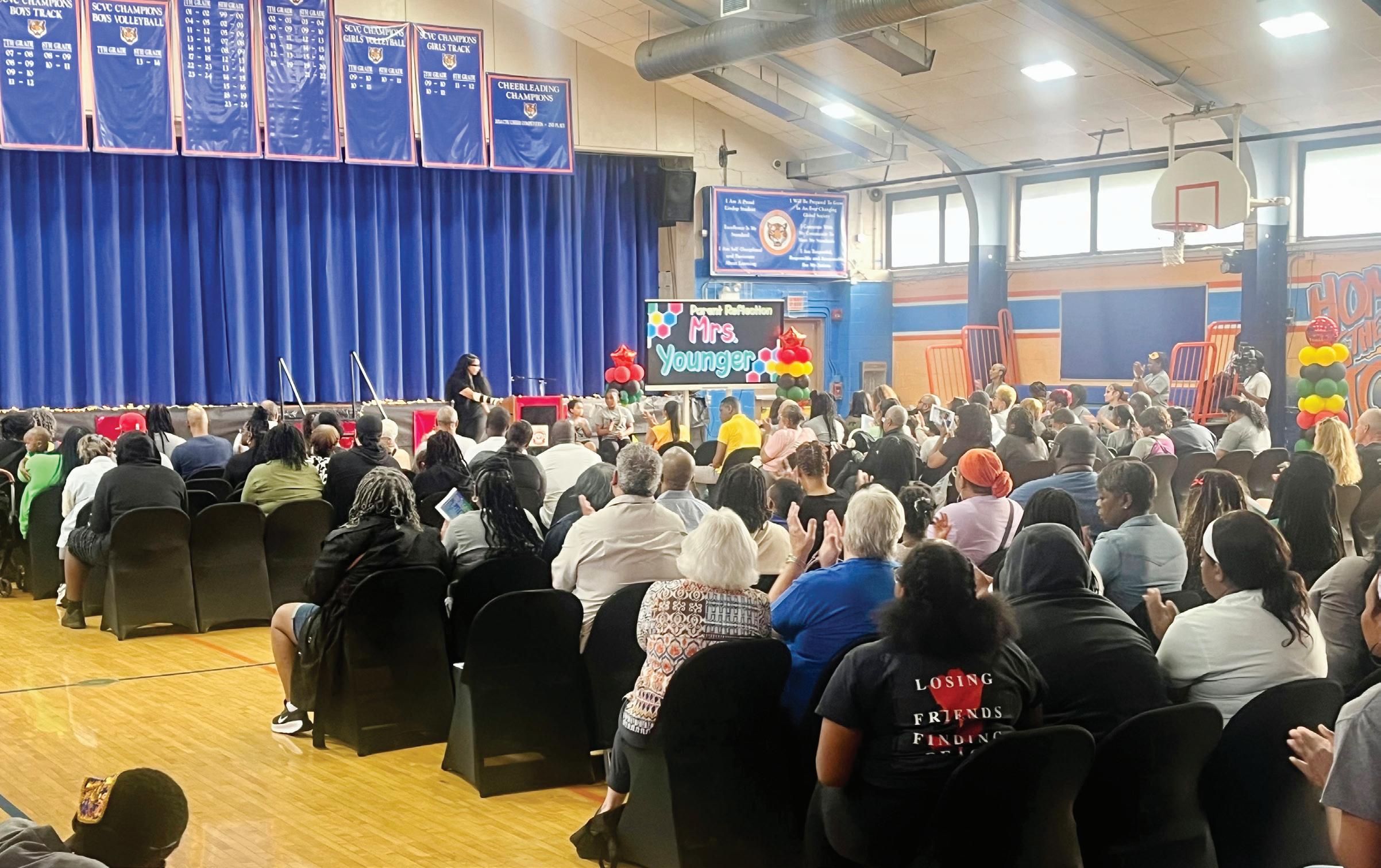

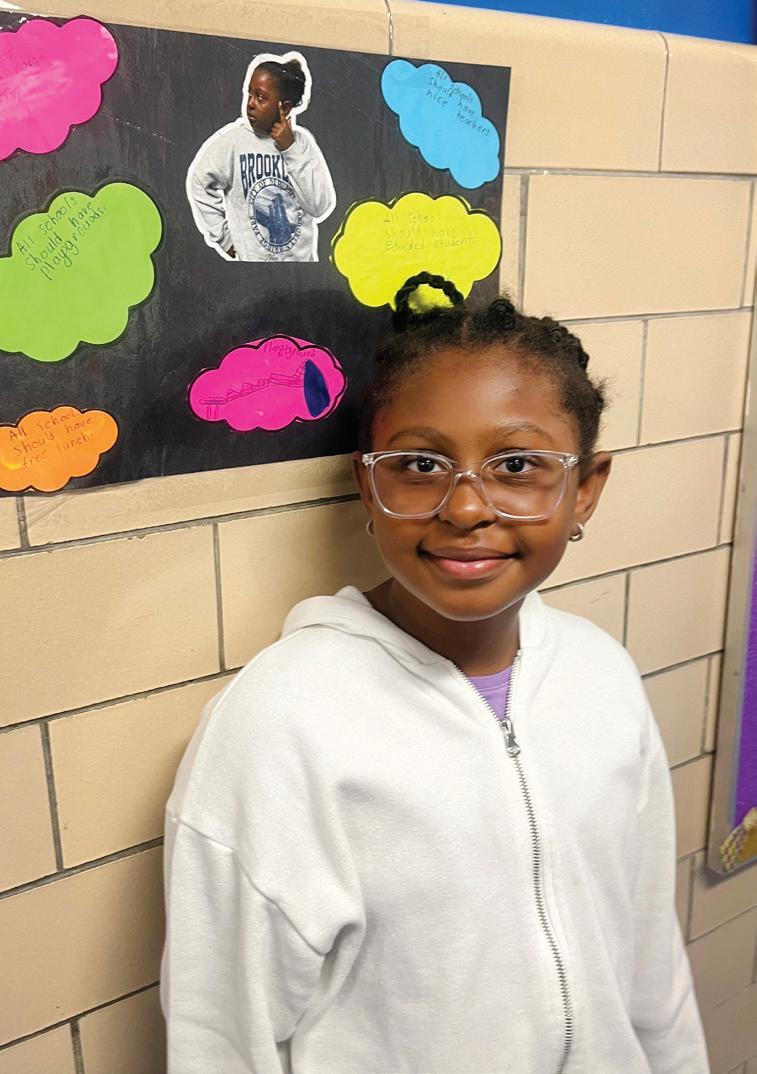
MICHAEL ROMAIN
Brianna Brown, (far right), a Lindop and Broadview Freedom School teacher, holds Tyrion Starks while posing with former students Kristyn Moore and Noel Lurks during the National Day of Social Action on July 17.
MICHAEL ROMAIN
Attendees pack Lindop’s gymnasium for the Broadview Freedom School finale on July 24.
MICHAEL ROMAIN
Alanna Moore stands in front of the poster she created.
MEDIA LITERACY
Unfunded from page 1
schools surveyed discuss media literacy during a single class period over the course of a full school year.
Illinois became the first state in the nation to require public high schools to teach media literacy, which can include lessons on accessing information, analyzing and evaluating media messages, reflecting on how media affects the consumption of information and triggers emotions, and how to engage in thoughtful conversations with people using facts and reason. The state-mandated lessons began with the 2022-2023 school year.
A key feature of the law is its “bottom-up approach” that gives local schools flexibility to design and deliver media literacy lessons as they see fit, said Yonty Friesem, an associate professor at Columbia College Chicago and a co-founder of Illinois Media Literacy Coalition, a group that helped develop a media literacy education framework that teachers could use to build lessons in wake of the new law.
While the local-control approach made the legislation more politically palatable, the flexibility brings major differences in what the students learn.
“We definitely don’t see the impact that we wanted to see,” Friesem said of the law. He recalled being asked to speak about media literacy in a high school class. The session lasted an hour.
“That was the unit of instruction,” Friesem said. “Which, yes, they’re correct, it is. But I would prefer it to be a little bit longer.”
Media literacy findings
Further illustrating Illinois schools’ variations on how they handle media literacy education, the UIS survey, taken in spring 2024, found:
Less than 82 percent of teachers said high school freshmen received media literacy instruction at their schools. That percentage decreases as students get older. Seniors received the training at 63 percent of the schools.
One-third of educators reported a student who attends their high school for all four years will experience a media literacy lesson four or more times. Another one-third of teachers say their students will see just one lesson over their four years in high school.
In Springfield, students are receiving the lessons in a variety of ways. Mike Havener, a library media specialist at Springfield High School, one of three public high schools in the capital city, arranges with other teachers

to bring their classes to the library so Havener can offer a session that covers media literacy. But even then, he doesn’t see every student in the building.
“I am not reaching with fidelity every student,” he said. “I mean, we range between high 1,300s to almost 1,500 students and just to get that quantity of kids through the library (for these lessons) … that is not happening.
I can say that I do see every student in some capacity. But that’s not always me teaching a media literacy lesson. They’re coming in for English. They’re coming in to get a book. … I try to sneak it in as much as possible. There are other teachers in the building that do teach media literacy as part of their normal coursework.”
For Heather Danek, who teaches public speaking courses at Minooka Community High School in the Chicago suburbs, media literacy lessons in her classroom are “interwoven throughout the class. It’s not just a one-and-done situation for me.”
“We start within the very first unit talking about meeting the needs of an audience and audience expectations which I think is part
of media literacy and thinking about the information that you’re using to create a point, thinking about the way that you’re building an argument using information,” said Danek, who serves on the Illinois Media Literacy Coalition. “And then, as we get further into like research projects, then I do more of the nuts and bolts of things like the true analysis of sources, looking at quality places to find information.”
‘It’s a pedagogy’
That approach — working media literacy into the everyday educational process — is what will make the lessons most effective, said Michael Spikes, the other co-founder of the Illinois Media Literacy Coalition and a lecturer at Northwestern University.
“It’s a pedagogy,” he said. “… Not so much like you got to go take the media literacy class, or you do media literacy when you have the unit, like what we have in the policy. … It’s a way of seeing the world the way you move through (it) more than just saying it’s just a subject that you learn.”
To that end, the UIS survey showed schools
are working media literacy lessons into a variety of courses.
Nearly 60 percent of respondents said the lessons are included in English courses, 47 percent in history/social studies, 33 percent in business classes, 29 percent in literature and 18 percent in civics. Just more than 16 percent of schools said they deliver the lesson in a separate media literacy course.
Danek said she sees her students displaying media literacy skills, including being more aware of the quality of the information they’re using and being able to find reputable sources in trustworthy places.
Lack of statewide oversight, funding
Still, a deficiency in the law, Danek said, is a lack of statewide oversight to ensure compliance in classrooms throughout Illinois, which leaves many schools, including hers, implementing the law on a “hit or miss” basis.
“If I had this conversation with any cur-
CAPITOL NEWS ILLINOIS FILE PHOTO
A stack of newspapers is pictured at the Illinois State Capitol.
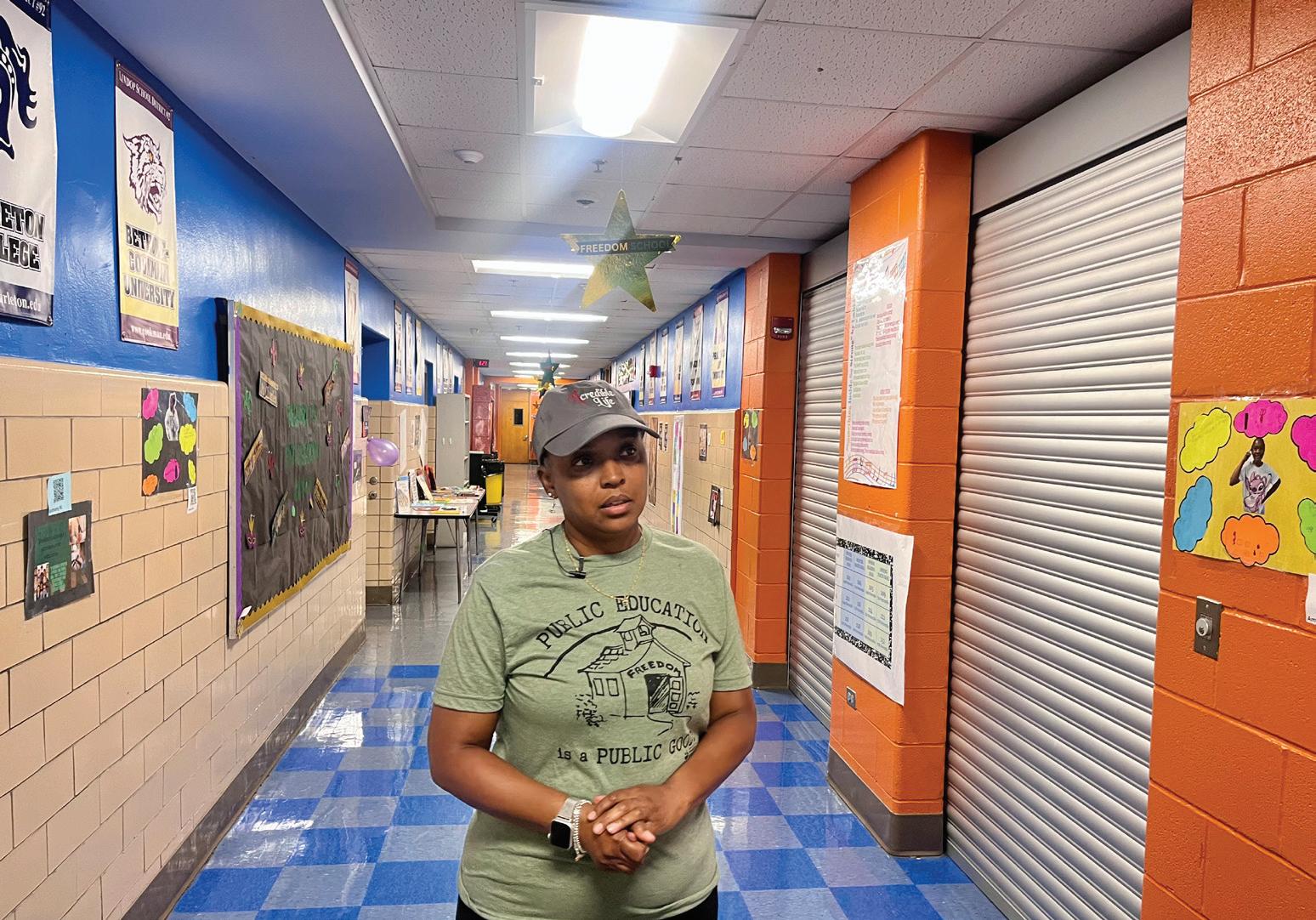
ROMAIN
Broadview Mayor Katrina Thompson speaks on Broadview Freedom School’s importance on July 17.
MEDIA LITERACY
Different standards from page 5
riculum director, or any building principal in the state of Illinois, I would hear the same answer,” she said. “… I think the challenges are communication. … How do we get the message out to people that they need to and should be doing this, and then how do we provide them with the necessary tools in order to do it?”
Another deficiency: The state didn’t set aside funds to train teachers to teach media literacy.
“I mean, it’s basically an unfunded mandate, right?” Danek said. “There wasn’t really any money put behind it. So, I think if you want a law that has some teeth, there has to be some money because you’re gonna need to identify ability, the opportunities for professional development.”
Other states’ policies
Just as Illinois school districts employ a variety of methods to teach media literacy, states around the country do, too.
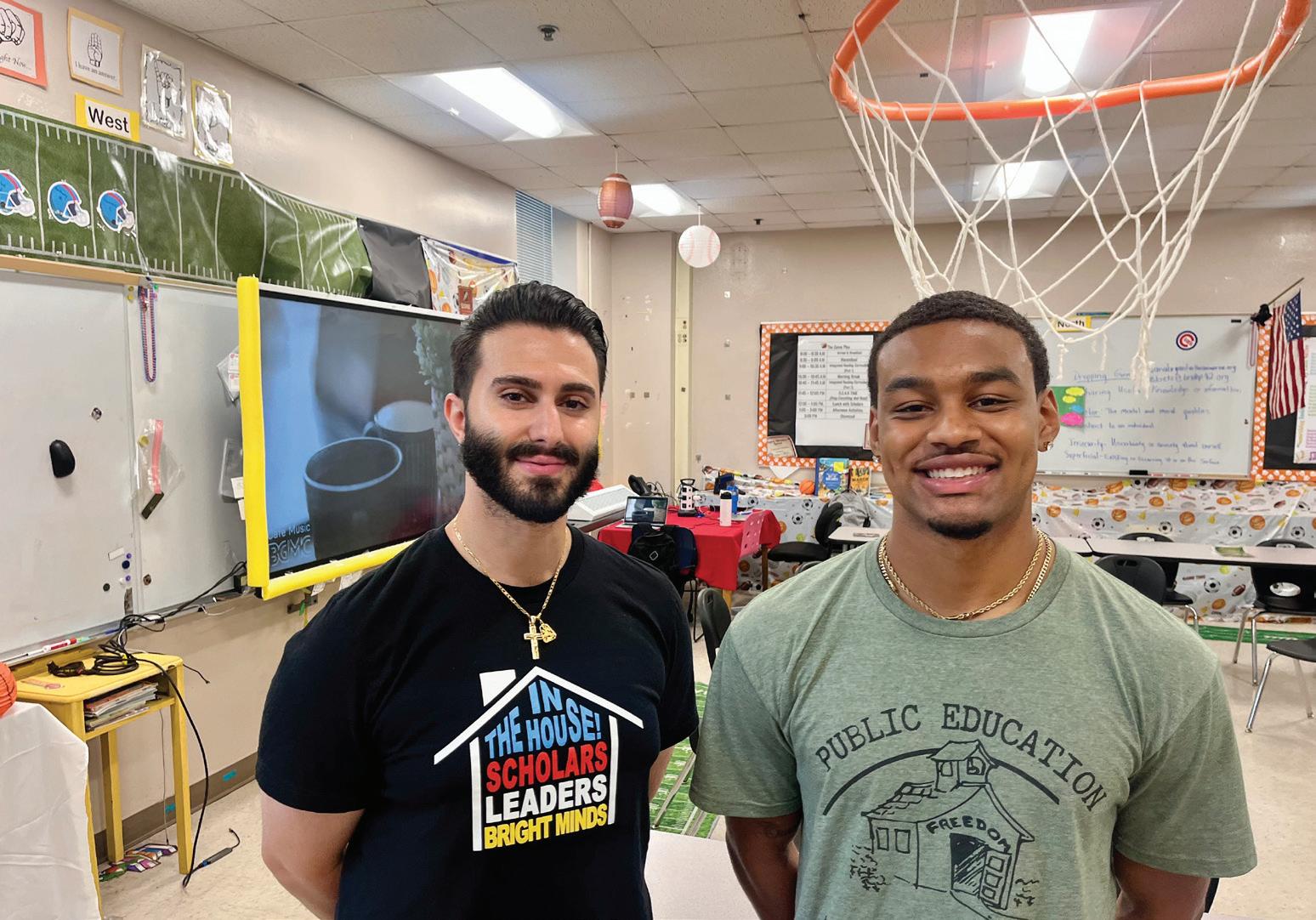
Teachers Tom Mousheh and Cameron Coppage stand inside of their Freedom School classroom on July 17.
As of the end of 2023, 19 state legislatures had approved bills or resolutions concerning “K-12 media literacy or digital citizenship education,” according to a policy report by Media Literacy Now, a group that pushes for the subject to be taught in public schools.
A study published in 2023 by University of Kentucky professor Daniela Kruel DiGiacomo and others examined state-level legislation and found the measures lack consistency in terms of substance, scope and intended implications.
Most legislation focuses on safety and civility in online environments but fails to address equity concerns adequately. Moreover, there is a notable lack of support in terms of funding, teacher training, and clear definitions of media literacy terms. The study underscores the need for comprehensive and coherent policy frameworks to effectively integrate media literacy education into the curriculum.
Back in Illinois, educators say identifying the skills of teachers and assessing the implementation of the law more comprehensively is another step toward making improvements. While the UIS survey offers snapshots into outcomes, a statewide assessment is something those interviewed see as a necessary step, perhaps coming from the Illinois State Board of Education.
“Students have to pass a Constitution test to graduate,” Havener, the Springfield High faculty member, said. “I think there should be a media literacy test and that it has equal importance in weight in order for kids to graduate.”
Partisan divide
Another way to promote buy-in on media literacy across the state is for educators to fully explain to the public what it entails.
Many people, educators say, equate media literacy to fact-checking and news literacy, one part of which is news consumers learning about biases that specific news organizations might have.
Those discussions often become lightning rods for political conflict and create the distrust each party’s faithful have for certain media outlets such as FOX News or MSNBC.
There was definitely a partisan divide in the Illinois legislature’s vote in 2021 on House Bill 234, which created the media literacy education law. In the House, the vote was strictly partisan, with all 68 “yes” votes coming from Democrats and the 44 “no” votes coming from Republicans. In the Senate, which passed the bill 42-15, three Republicans crossed over to vote in favor along with Democrats. Illinois Republicans who opposed the measure in 2021, however, spoke in a legislative
committee meeting about their beliefs against creating a statewide curricular mandate and didn’t specifically speak against the concept of media literacy.
Friesem said the full concept of media literacy goes beyond the news.
“The main pushback from conservatives is that (media literacy) is liberal indoctrination, which is the exact opposite, because real media literacy … is to learn to ask questions,” he said. “… So it’s not about if you’re conservative or liberal, you’re media literate or you’re not media literate. It’s about … questioning who is in power, why they’re there, why they’re sending those messages, why people who are not in power are sending those messages, the context.”
Dr. Ann Strahle is interim associate dean and a professor in the College of Public Affairs and Education at the University of Illinois Springfield. Jason Piscia is an associate professor and director of UIS’ Public Affairs Reporting program. The UIS survey was conducted in spring 2024 by contacting more than 750 high school principals at Illinois’ public high schools, asking them or other faculty at their schools to fill out a 19-question survey about how the media education law is being implemented in their building. Forty-nine responses, all anonymous, were received.
MICHAEL
MICHAEL ROMAIN
SUCCEED WITH STYLE!
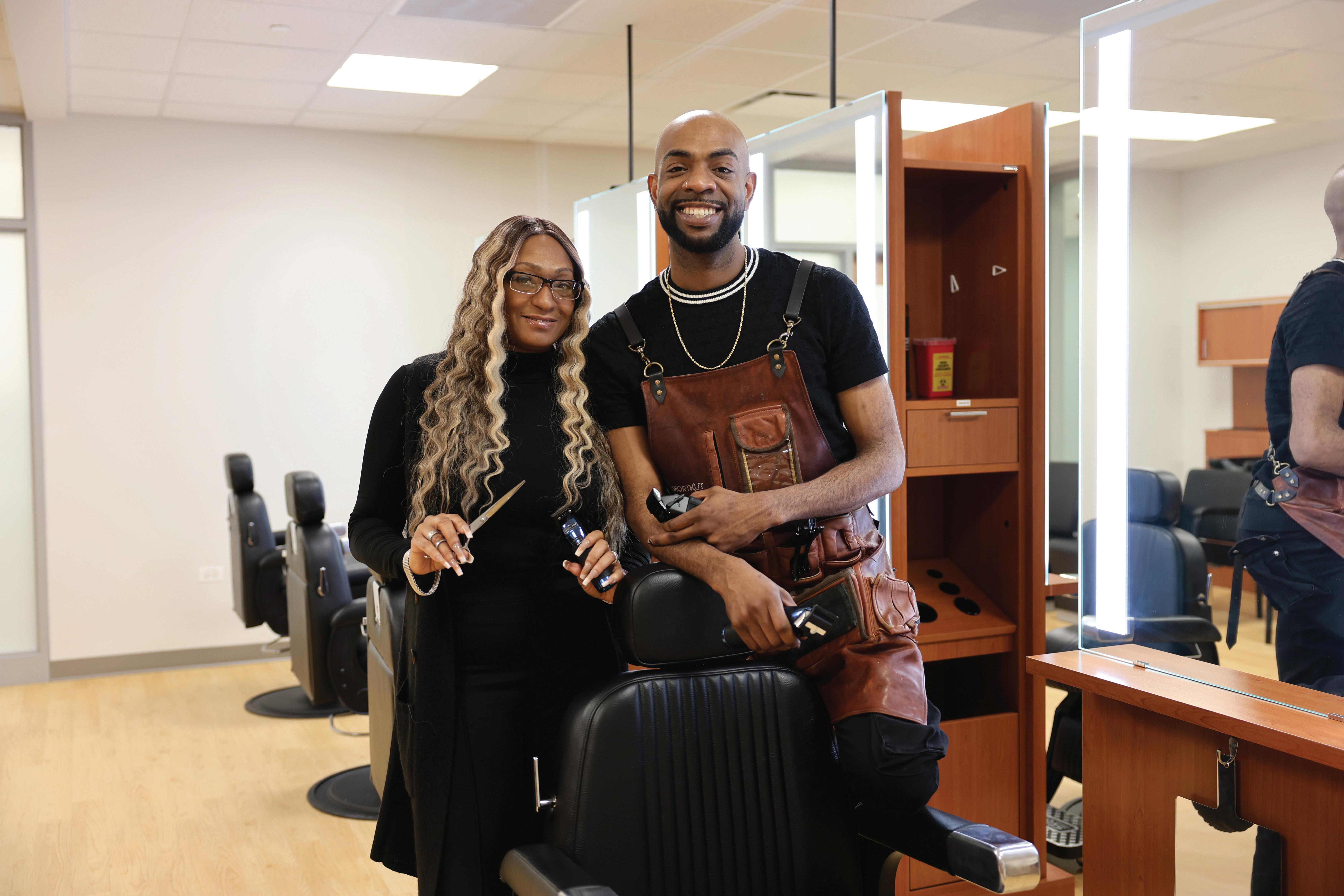
Cosmetology Program
Working alongside Triton’s established Barber Certificate Program, the cosmetology track opens the door to a fast-growing field with a variety of career paths – from salons and spas to fashion, entertainment and entrepreneurship. Industry demand is rising, with job openings for hairstylists, estheticians and nail technicians projected to grow steadily in the coming years.
For information about our Cosmetology Program, go to triton.edu/cosmetology or scan the QR code.
Barber Program
Are you ready to turn your passion for style and grooming into a rewarding career? The Barber Certificate Program at Triton College provides hands-on training, industry knowledge and professional certification preparation to help you succeed in the field of barbering. Join us at Triton College and take the first step toward a dynamic career in barbering. Your future starts here!
For information about our Barber Program, go to triton.edu/barber or scan the QR code.
